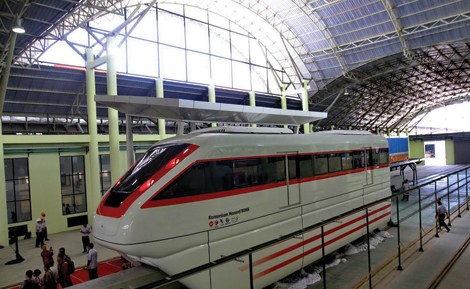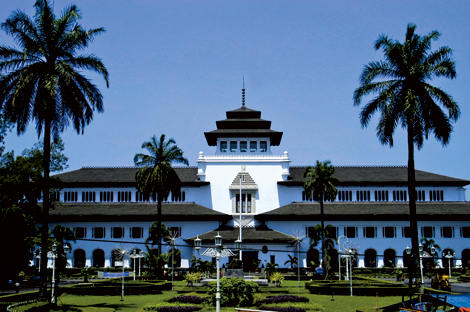When Indonesia announced its new president in July, the country of 250 million people collectively held its breath. Citizens of the archipelago weren’t the only ones: after months of stock market rallies banking on the victory of Jakarta Governor Joko Widodo, investors watching Southeast Asia’s largest economy were also looking for a resolution to the intensely fought election.
After the dust settled, Widodo, or Jokowi as he is popularly known, was left with a nation inspired by the triumph of a former furniture salesman who began his political career as the mayor of Surakarta, or Solo, in central Java – viewed as a “clean” reformer in a system long dominated by an “old guard” elite. His victory also marks the ascension of a new tide of political leaders, namely mayors buoying the progress of Indonesia’s second-tier cities through effective governance and reform.
As Widodo takes the reins of power, Indonesia is already booming with the spoils of a US$878 billion GDP and a steady 6 per cent economic growth rate, though issues of ineffective infrastructure and a corruption-plagued political system loom large. The nation’s capital of Jakarta, long known as the business centre of the nation, is giving way to up-and-coming business cities thanks to increased accessibility, attracting investment in specialised industries and services. Meanwhile, the “Big Durian” is getting a cosmopolitan makeover of its own, with new upmarket hotels, mixed-use complexes and a potentially transformative mass rapid transit system.
The question remains whether Widodo and his new government can maintain Indonesia’s tremendous growth and strengthen what some analysts have called a “fragile” economy.

Capital gains
While most contemporary airports go for the sleek and surreal, touching down in Soekarno-Hatta International Airport is an immediate reminder of your destination. Gently sloping Javanese-style pavilions amid tropical gardens greet you upon arrival. But as the world’s eighth busiest airport by traffic (62.1 million passengers travelled through it in 2013), Soekarno-Hatta is in need of serious renovation.
The airport is currently running over capacity and plans are already underway to expand Terminal 3 to a capacity of 25 million passengers annually. State-owned airport operator PT Angkasa Pura II has optimistically said it hopes to complete the Terminal 3 upgrade by the end of 2015, with additional plans to upgrade Terminals 1 and 2. The upgrade would include a mixed-use building connecting Terminals 1 and 2 with a train station, retail area and hotels. The entire renovation project is estimated for completion in 2020 and US$22 million has been allocated for the first phase from 2010 to 2016.
When visiting the archipelago’s second-tier cities, you would do well to position yourself in Jakarta. Soekarno-Hatta offers more than 50 flights per day to Surabaya in East Java and more than 35 to Makassar in South Sulawesi. Jakarta is also easily accessed from the region, with connections to Bangkok, Hong Kong, Shanghai, Tokyo, Taipei, Singapore and other major cities.
While Jakarta might get a bad rap for its notorious traffic owing to its population of 10 million people, or 28 million if you include the greater metropolitan areas, and pedestrian-unfriendly streets, the city has been quietly transforming into a dynamic megalopolis with a taste for the luxurious under the governorship of Widodo. Most telling is the appetite of real estate developers for mixed-use complexes. Space is at a premium in Jakarta’s central districts, and congestion means less mobility for consumers, so developers create massive complexes combining hotels, shopping malls, apartment living and parking lots.
Korean retailer LotteShopping Avenue is one of those developments in central Jakarta. The branded department store has a total area of 77,000 sqm, divided into seven floors – a new behemoth in an already mall-dense city. It is part of Ciputra World, a mega-complex by Indonesian developer PT Ciputra Property that will eventually include 15 skyscrapers across 13 hectares of land in the Kuningan business district. The US$1.78 billion project will include an art museum, eco-urban living space for young executives and a W Hotel when completed. Last year Ciputra reported an annual net income growth of 38.5 per cent, for a total income of US$38.9 million.
Jakarta will also see a slew of extravagant hotel openings in the next three years. Along with the W Hotel, Fairmont, St Regis and Rosewood properties are all slated to open in central and south Jakarta. These join an existing set of five-star hotels, including a Four Seasons, Shangri-La and two Ritz-Carltons. The new Fairmont will boast 374 spacious guestrooms, 114 suites and 3,500 sqm of function space. The 124-room St Regis is part of a 141,000 sqm mixed-use complex, a development encompassing a 47-storey office tower, dedicated food and beverage section and a retail component designed by Pelli Clarke Pelli Architects, who were responsible for The St Regis Mexico City.
Compared to neighbouring Singapore and Kuala Lumpur, Jakarta is woefully short of public transport options, with only a busway system that is seriously overburdened. The government has begun work on an above- and below-ground mass rapid transit system, under the leadership of Widodo, with the main structure of the station to be completed in 2016. The US$1.29 billion project, funded by a soft loan from the Japan International Cooperation Agency (JICA), will have six underground stations, seven elevated stations and a capacity of 173,000 passengers per day. The project is slated for completion in 2017.

A monorail project is also underway, but the project is in need of government permits before it can begin construction. The US$1.2 billion project will include two lines, covering 30km of land, and will take 3.5 years to build.
“A mass rapid transit system will bring Jakarta forward,” says David Aditya Soeryadjaya, managing director of Ortus Holdings, an asset management firm investing in the new monorail project. “It will give new options to citizens of Jakarta and an alternative to the road system, which does not exist now.”
Future tech hub
Three hours’ drive from the capital of Jakarta — or a perilous train trip on the Argo Gede railroad — and you arrive at the city of Bandung. Located in a river basin at the foot of surrounding mountains, Bandung was dubbed the “Paris of Java” during Dutch rule for its cool climate and bohemian character. The city still retains much of its colonial charm, with scattered Art Deco architecture and open-air cafes sourcing locally grown coffee beans and tea. It was named one of the top ten most liveable cities in Indonesia in 2014.
Bandung has back-pedalled in recent years owing to the woes that rapid urbanisation entails, such as gridlocked traffic, government corruption and rising social inequality. With a population of 2.5 million people, Bandung is the third largest city in the nation. Its upstart young mayor, Ridwan Kamil, a former architect and university lecturer, has invigorated the city government and announced his intention to position Bandung as the “Silicon Valley” of the archipelago.
Known to Singaporeans and Malaysians for its affordable shopping and trendy boutiques, Bandung has long been a hub for manufacturing and textiles. On weekends, the city is flooded with Jakarta residents looking for factory discounts and a respite from the capital. Even so, the Bandung government is looking to distance itself from being known just for its retail attractions and weekend amusements.
“Bandung’s main problems, among others, are congestion, overcrowding, a lack of green space and destruction of its historical buildings,” says Ferry Ridwan, a renowned architect from Bandung and former colleague of Mayor Kamil. “With his academic background in urban planning, I do think Mayor Kamil can improve the city’s problems.”
Some of Indonesia’s top universities are located in the city, including Bandung Institute of Technology and Universitas Padjadjaran, meaning the city teems with a young, educated workforce — about 60 per cent of the city is under 40 years old. Mayor Kamil hopes to capitalise on this labour force by specialising in human resources and technology industries. He has announced plans for an ambitious “Bandung Teknopolis” – an 800-hectare planned city to attract start-ups and tech talent, costing an estimated US$800 million. Bandung also boasts 5,000 free wifi hotspots to increase connectivity, with plans for a total of 40,000. To further attract tech companies, Mayor Kamil has proposed offering tax incentives and subsidised office space.
A top priority for the city administration is fighting the annual flooding by improving drainage, and tackling traffic problems exacerbated by weekend visitors. A long delayed “Sky Bridge” cable car was announced in 2012, but residents are banking on a US$1.5 billion monorail project, funded by the state-owned China National Machinery Import & Export Corporation, to help alleviate traffic. The first route, stretching nearly 30km, is expected to open in 2017, with all routes estimated for completion by 2025.
Bandung’s humble Husein Sastranegara International Airport is also due for an upgrade, with construction set to begin in September on a terminal expansion project. The airport currently has international flights to Kuala Lumpur and Singapore. The new project will triple the airport’s annual capacity to 3 million passengers. Mayor Kamil will assist in the planning of the architecture for the modern terminal, a role that is near and dear to the former architect.
Going green
East Java is one of the great success stories of Indonesia’s economy today and the city of Surabaya is leading the charge. With a population of just over 3 million people, it is Indonesia’s second largest city after Jakarta and boasts an annual economic growth rate of 7.3 per cent, higher than the national rate of 6.2 per cent. Surabaya is often considered the gateway to the heavily populated East Java.
The city’s mayor, Tri Rismaharini – often grouped together with transformative politicians like president-elect Jokowi Widodo and Bandung Mayor Ridwan Kamil – has revitalised the city through public works projects. Eleven new parks have been unveiled around the city, improved pedestrian pathways and cycleways are giving residents alternative commuting options, while car-free Sundays encourage an active city and vibrant civic core.
“Surabaya is a growing city with a diverse economic base and a proactive local government with strong leadership,” says Josephine McVitty, a World Bank urban specialist who consults on projects within the city of Surabaya. “The city government is making strategic policy reforms and investments in public services to work toward their development agenda of becoming a competitive, inclusive and sustainable city.”
Mayor Rismaharini has also tackled significant corruption issues with a transparent e-procurement system that improves accountability and efficiency for an estimated saving of 22.9 per cent of procurement costs. She has notoriously addressed the city’s red light district, offering cash handouts in return for brothel owners and sex workers seeking new opportunities.
Surabaya boasts the main trading port in East Java, Tanjung Perak, one of the ten busiest cargo ports in Southeast Asia and the second busiest in Indonesia. Primary exports include sugar, tobacco, coffee and agriculture exports from the region. State-owned port operator PT Pelindo III has awarded a contract worth US$76 million to Dutch company Van Oord Dredging and Marine Contractors BV to carry out a widening project at the port, estimated for completion in 2015.
The city's airport, Juanda International, unveiled its new Terminal 2 this year, with an additional capacity of 6 million passengers per year to meet the traffic of its 17 million passengers annually. The new facilities include 40 check-in counters, a modern baggage handling system, nine gate lounges and 12 aerobridges. Terminal 2 houses all international carriers, including Garuda Indonesia, AirAsia, Cathay Pacific, Jetstar and EVA Air. Bangkok, Kuala Lumpur, Singapore, Hong Kong and Taipei are all connected with non-stop flights. Juanda airport claims the title of the second busiest airport in Indonesia, after Soekarno-Hatta in the capital.
“Even though Surabaya is a very promising city, it struggles to access long-term finance to execute larger-scale infrastructure projects. This has resulted in a large infrastructure deficit and urban sprawl that creates a lot problems, such as congestion, which negatively impact the business environment,” says the World Bank’s McVitty. “For example, it's impossible to predict transportation time and logistics costs, either between meetings, or for the transportation of goods.”

Next up for the city is an ambitious intra-city mass rapid transit development plan. The proposed system comprises an integrated 16.6km tramline along the north-south corridor of the city and 23km monorail along the east-west corridor. The estimated US$300 million first phase has yet to announce potential investors, with 40 per cent funded by the state budget and the remainder open for bids from outside investors.
Along with improving public transportation to reduce congestion, Surabaya is making strides to establish itself as a green city. The government is developing a green building code with the aim of reducing carbon emissions and improved energy efficiency.
On the waterfront
When nutmeg was worth its weight in gold and wars were fought for spices, Makassar served as the cosmopolitan trading centre for Eastern Indonesia. Its strategic location by the sea and access to the surrounding region has allowed Makassar to continue this legacy by becoming a modern port city and transportation hub. Like Bandung, it was named one of the most liveable cities in the Indonesian archipelago this year.
Located in South Sulawesi, Makassar is the largest city in East Indonesia with 1.3 million people. The city is currently experiencing 8.5 per cent economic growth annually, higher than the national average of 6.2 per cent.
“Development in Makassar and South Sulawesi, especially in the last ten years, has shown remarkable growth,” says Fauzi Rahman Rahim, a university lecturer in Makassar and entrepreneur. “This is especially visible in the increase of purchasing power that has resulted in increased public consumption.”
Makassar has shown its economic prowess by being the first of a string of second-tier Indonesian cities to revamp their airports. Its Sultan Hasanuddin International Airport unveiled its second terminal in 2008, a shiny, futuristic structure capable of handling 7 million passengers per year. Makassar airport is already nearing overcapacity, however, with more than 8 million passengers expected by the year’s end and 13 million over the next five years at its current rate of growth. The majority of its traffic is from domestic destinations, including Jakarta, Bali and Surabaya, but international flights are available to Singapore and Jeddah.
The city’s greater public transport system is lagging, however, as its monorail project has been little more than lip service at this time. Its busway transit system has also failed to reach critical mass after it was deemed cost-ineffective in trials. Traditional pete-pete and becak crowd the streets along with taxis, mini buses, motorbikes and cars.
The city’s economy continues to bank on its role as a busy port city. Local and international cargo ships line up daily at Soekarno-Hatta Port. State-owned port operator PT Pelindo IV plans to launch construction of the US$637 million Makassar New Port later this year in an effort to alleviate congestion at the city’s existing port and meet increases in traffic. A 106-hectare site for the port’s container terminal, and a multipurpose terminal, is planned. The new port will allow larger, modern vessels to enter its waters.
Makassar remains a major fishing centre in Indonesia and at the city’s traditional port, one can still see the Bugis pinisi schooners unloading fresh seafood and goods from surrounding islands. The city’s economy also competes in the service sector as it functions as a hub for shipping and a transit gateway to Eastern Indonesia. Hospitality, communication and finance sectors to support logistical industries in the city are growing, as the historic port of Indonesia finds its modern persona.
On the right track
The coming months will pose tough questions for Widodo, including how to connect the nation’s 17,000 islands, tackle income inequality and protect the economy from volatile market fluctuations. His political peers, including Bandung Mayor Kamil and Surabaya Mayor Rismaharini, have already shown how effective governance on a city level can bring sustainable investment and reduce corruption. Indeed, Widodo is no stranger to such theories as the former mayor of Solo. His no-nonsense political agenda and grassroots approach to vetting citizens’ complaints only bolstered his authority as governor of Jakarta. As Widodo begins his presidential term, perhaps he can look within Indonesia’s rising cities, and his own political track record, as a microcosm for greater Indonesia’s development.








